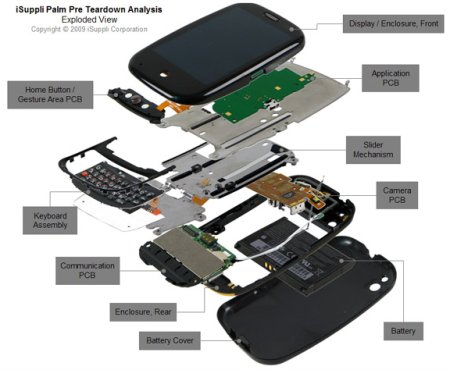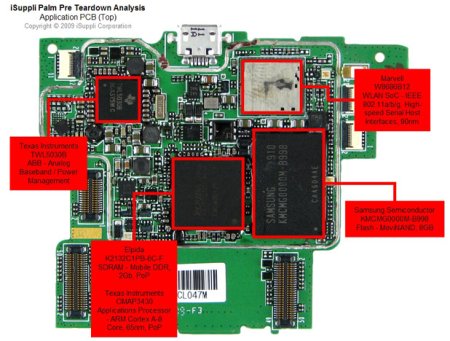Palm’s Linux phone “exceptional,” says reviewer
Jun 12, 2009 — by Eric Brown — from the LinuxDevices Archive — 5 views The reviews appear to be largely positive for the Palm Pre, with eWEEK lauding its “exceptional design, aesthetics and usability.” Both the smartphone and the Linux-based WebOS stack live up to their billing for ease of use, but battery life is a problem, says eWEEK.
The reviews appear to be largely positive for the Palm Pre, with eWEEK lauding its “exceptional design, aesthetics and usability.” Both the smartphone and the Linux-based WebOS stack live up to their billing for ease of use, but battery life is a problem, says eWEEK.
Since the Palm Pre shipped last Saturday, available to Sprint's 3G customers for $200 with contract, the phone been pulled apart and run through its paces by dozens of reviewers. The vast majority of the Pre reviews appear to be favorable, with many reviewers glowing over the phone's design and user interface, but also critiquing its battery life.
Several reviews came to the same conclusion: The Pre may not be an Apple iPhone killer, especially with the arrival this week of the iPhone 3GS, but with its multitasking and synchronization features, it may give RIM's BlackBerry a run for its money in the corporate market. Others note that in order to do that, however, the device will first need to spread beyond the Sprint network, as planned for early next year, to Verizon Wireless and possibly AT&T. Palm will also need to quickly boost the number of available WebOS apps, say reviewers.

Palm Pre
The 3G-enabled Palm Pre is also competing with a new crop of Linux-based smartphones, especially those running the Google-sponsored Android stack. These includes the HTC G1 and and Magic phones, and the new I7500 phone from Samsung, which is scheduled to go on sale this month.
Several more Android phones and netbooks from Acer and others were announced at last week's Computex show, pushing the expected number of Android phones to about 20. The LiMo Foundation says that a similar number of phones adhering to its rival Linux Mobile (LiMo) spec should arrive this year.

An exploded view of Palm's Pre
Source: iSuppli
(Click to enlarge)
eWEEK on Pre: Easy, fun, and totally synchronized
One of the more thorough reviews arrived this week from our sister publication, eWEEK,, written by Andrew Garcia. eWEEK also published a hardware breakdown performed by iSuppli that detailed an “unusual” mix of processors used on the chip. The ARM Cortex-A8-based Texas Instruments (TI) OMAP3430 system-on-chip (SoC) runs the show, while other chips include Qualcomm baseband processors, a Marvell WiFi chip, Samsung flash memory, and — most unusual in iSuppli's view — a power management processor from Maxim.

Inside the Pre: application processors
Source: iSuppli
(Click to enlarge)
As with most of the Pre reviews, eWEEK's take lauded the phone's touchscreen, keyboard, and overall design. Reviewer Garcia seemed particularly taken with the gesture area, which allows user to swipe right to left to go back to a previous page, website, or mode, and a reverse swipe to go forward. The review also praised the Linux-based WebOS software and overall UI, commenting that the Quick Launch bar and other UI elements make the Pre “quite easy and fun to navigate.”
Garcia was particularly enthused with the Palm Synergy synchronization feature. “WebOS does the best job of any smartphone platform I've tested to date at helping users juggle personal information from multiple data sources,” he writes. The reviewer also liked the way the Pre's search function “removes the distinction between searching the device and searching the Web.”
Slow boots and a beleaguered battery
On the down side, Garcia found that boot times were uncommonly long, as much as 90 seconds. While in general, multi-tasking seemed smooth, and more intuitive than with most smartphones, writes Garcia, “when launching applications or switching between applications, the device sometimes took longer than expected to complete the actions.”
Battery life seemed to run even better than the five hours talk time touted by Palm when using a “refreshed” phone for talk and other basic functions, but it plunged to just under three hours when doing extensive multitasking and using advanced features, writes Garcia. In addition, the device “frequently ran much hotter than I felt comfortable with.”
All in all, however, Garcia gives the phone a thumbs up. “The Palm Pre is a beautiful smartphone, with clean lines, intuitive controls and a lovely screen,” concludes Garcia in an eWEEK Labs overview. “But the real star is Palm's long-awaited WebOS operating system, which offers easy-to-grasp controls that help the user move among simultaneously active applications.”
Availability
The Palm Pre is available now, with more information available here.
The eWEEK review of the Palm Pre, “Palm Pre Is Beautiful to See and Use, Says eWEEK Labs,” may be found here.
An accompanying slide show revealing the testing process, may be found here.
Follow-up comments on the Pre may be found in Andrew Garcia's blog, here.
A slideshow of the Pre breakdown, provided by iSuppli, may be found here.
This article was originally published on LinuxDevices.com and has been donated to the open source community by QuinStreet Inc. Please visit LinuxToday.com for up-to-date news and articles about Linux and open source.